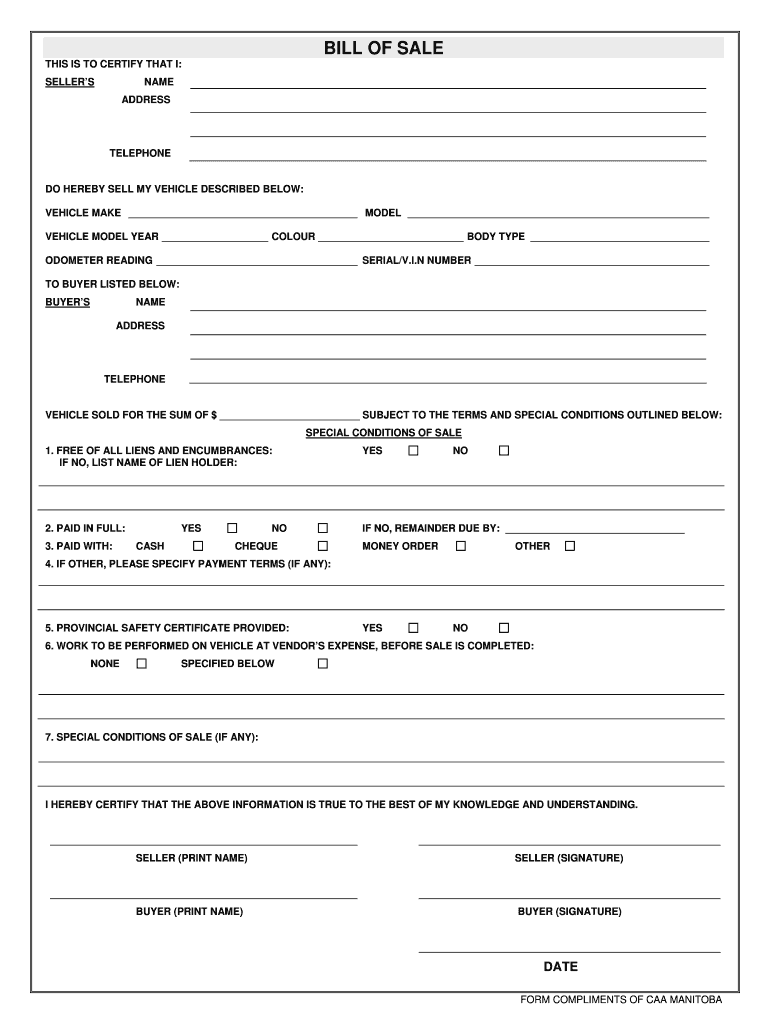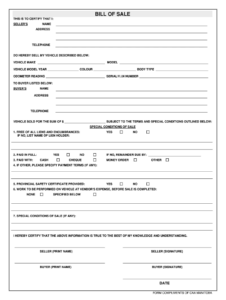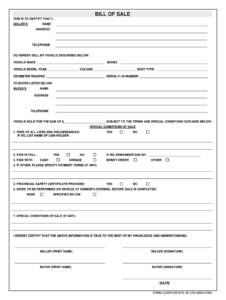When you are buying or selling a vehicle, especially in Manitoba, having the right documentation is crucial. A bill of sale isn’t just a formality; it is a vital legal document that formalizes the transfer of ownership from one party to another. It protects both the buyer and the seller by clearly outlining the terms of the sale, the condition of the item, and the agreed-upon price. This clarity helps prevent misunderstandings down the road and provides a solid record of the transaction.
For anyone dealing with vehicle ownership changes in Manitoba, understanding the specific requirements set by Manitoba Public Insurance, or MPI, is paramount. They are the authority responsible for vehicle registration and insurance in the province. Without a properly completed bill of sale that meets their standards, you might face delays or complications when trying to register your newly acquired vehicle. This is precisely why a reliable bill of sale template tailored for MPI’s needs becomes an invaluable tool.
Understanding the MPI Bill of Sale Requirement
Manitoba Public Insurance (MPI) serves as the sole provider of automobile insurance in Manitoba and is responsible for driver and vehicle licensing services. When a vehicle changes hands, MPI requires a clear, comprehensive bill of sale to process the transfer of ownership and update their records. This document verifies who sold the vehicle, who bought it, and on what terms. It’s not just about proving you own the car; it’s also about ensuring the vehicle’s history is accurately tracked and that all legal and insurance obligations can be met by the new owner.

MPI looks for specific information on a bill of sale to ensure the transaction is legitimate and complete. Omitting key details or providing inaccurate information can lead to significant delays in getting your vehicle registered and on the road. The clarity and completeness of your bill of sale directly impact how smoothly your registration process will go. It is in everyone’s best interest to provide all the necessary information upfront, ensuring there are no missing pieces that could halt the process.
What MPI Looks For
- Full legal names and addresses of both buyer and seller.
- Contact information for both parties.
- Complete vehicle description, including VIN, year, make, model, and colour.
- The agreed-upon purchase price.
- Date of sale.
- Signatures of both buyer and seller.
- Clear statement of transfer of ownership.
Using a bill of sale template MPI can approve simplifies this entire process significantly. These templates are designed to include all the fields and sections that MPI typically requires, helping to ensure you don’t miss anything important. They act as a helpful checklist, guiding you through the necessary information input, from the vehicle identification number to the final agreed-upon price. This level of preparedness allows for a much smoother experience when you visit MPI to finalize your vehicle’s registration, saving you time and potential frustration.
Steps to Effectively Use Your Bill of Sale Template
Before you even start filling out your bill of sale template, it is a good idea to gather all the necessary information. This includes the full legal names, addresses, and contact details for both the buyer and the seller. For the vehicle itself, you will need its year, make, model, color, and most importantly, the Vehicle Identification Number (VIN). Having these details readily available will make the process of completing the document much faster and reduce the chances of errors. It is always better to be over-prepared than to have to scramble for information while the other party waits.
When you begin to fill in the template, proceed carefully, field by field. Double-check every piece of information, especially the VIN, against the vehicle’s existing registration or the vehicle itself. A single digit error in the VIN can cause serious issues with MPI. Ensure the purchase price is clearly stated in numbers and, if possible, in words to avoid any ambiguity. If the vehicle is being sold “as is,” it is also wise to include a statement to that effect to protect the seller from future claims about the vehicle’s condition.
The signing of the bill of sale is perhaps the most critical step. Both the buyer and the seller must sign and date the document in the presence of each other. This act legally acknowledges the transfer of ownership and the agreed terms. It is highly recommended to make at least two identical copies of the completed and signed bill of sale: one for the buyer to take to MPI for registration purposes and one for the seller to keep as proof of sale. Having these copies ensures both parties have a record of the transaction.
- Gather all required information for both parties and the vehicle.
- Fill in each field carefully, ensuring accuracy and legibility.
- Verify the VIN and other vehicle details against the vehicle itself or its registration.
- Agree on the final sale price and note it clearly.
- Ensure both the buyer and seller sign and date the document.
- Make at least two copies: one for the buyer and one for the seller.
- Present your copy to MPI when registering the vehicle.
Beyond its immediate use for MPI, a properly executed bill of sale serves as a crucial legal safeguard for both parties involved in the transaction. For the buyer, it is definitive proof of ownership, essential for insurance claims, future sales, or resolving any disputes. For the seller, it provides a clear record that they are no longer the owner of the vehicle, which can be critical for liability purposes, particularly concerning parking tickets or accidents that occur after the sale. It simplifies accountability and ensures a clean transfer.
Ultimately, using a comprehensive bill of sale streamlines the entire vehicle transaction process in Manitoba, making it less stressful and more secure. It acts as your official record, protecting your interests and ensuring a smooth transition of ownership, satisfying all provincial requirements.



